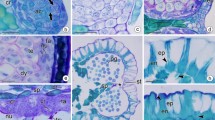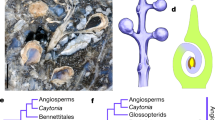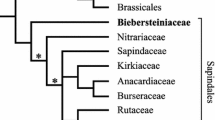Lingelsheimia
) are distinct from the rest of the subfamily in having a thick inner integument (over six cells thick), an exotegmen composed of cuboidal cells (type II), and vascular bundles in the outer integument and, as molecular evidence also suggests, should be transferred to a separate family Putranjivaceae. Hymenocardieae (Didymocistus and Hymenocardia), whose positions have been controversial, are monophyletic in sharing endotestal seeds with a collapsed exotegmen which is unknown elsewhere in Euphorbiaceae. The genera seem to require separation from the Euphorbiaceae. In addition, a morphological heterogeneity of the two large genera Cleistanthus and Phyllanthus, as well as of tribe Antidesmeae subtribe Scepinae were also discussed.
Similar content being viewed by others
Author information
Authors and Affiliations
Additional information
Received 20 October 2000/ Accepted in revised form 14 January 2001
Rights and permissions
About this article
Cite this article
Tokuoka, T., Tobe, H. Ovules and Seeds in Subfamily Phyllanthoideae (Euphorbiaceae): Structure and Systematic Implications. J Plant Res 114, 75–92 (2001). https://doi.org/10.1007/PL00013970
Issue Date:
DOI: https://doi.org/10.1007/PL00013970




